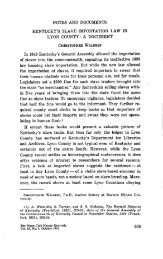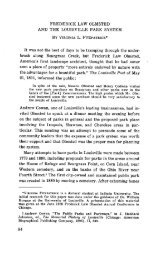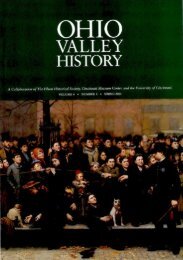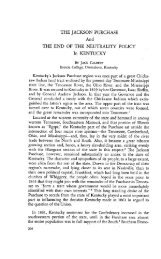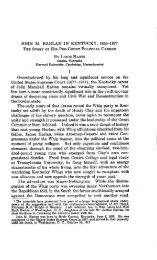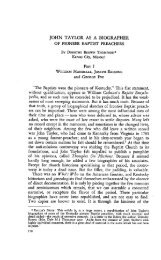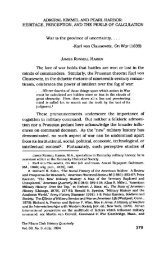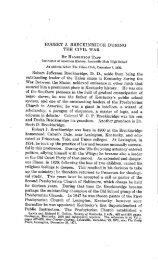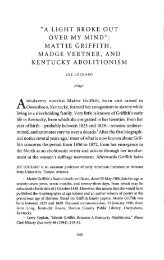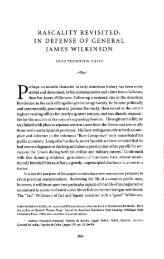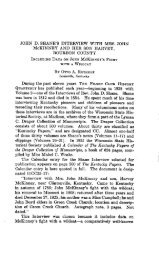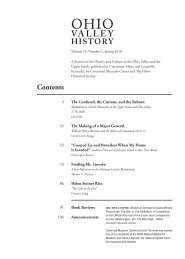The Lexington Civic League: Agent of Reform, 1900 - The Filson ...
The Lexington Civic League: Agent of Reform, 1900 - The Filson ...
The Lexington Civic League: Agent of Reform, 1900 - The Filson ...
Create successful ePaper yourself
Turn your PDF publications into a flip-book with our unique Google optimized e-Paper software.
354 <strong>The</strong> <strong>Filson</strong> Club History Quarterly [July<br />
was also greatly influenced by Chicago Progressives who were<br />
at the forefront <strong>of</strong> the reform movement. Many <strong>of</strong> the speakers<br />
the <strong>Civic</strong> <strong>League</strong> brought to <strong>Lexington</strong> reflected this connection)s<br />
Perhaps Mrs. Breckinridge and the other <strong>Lexington</strong> reformers<br />
are best described as proponents <strong>of</strong> the concept <strong>of</strong> noblesse<br />
oblige as defined by Kathleen McCarthy in her book Noblesse<br />
Oblige, Charity & Cultural Philanthrophy in Chicago, 1849-1929<br />
in which she defines noblesse oblige as "the notion that success-<br />
ful citizens owe a dual obligation <strong>of</strong> time and money to the communities<br />
in which they have prospered." As John Burnham has<br />
written, they were people who could not stand idly by while<br />
they saw social wrongs.40 Certainly the <strong>Lexington</strong> Progressives<br />
did not seek revolutionary goals, but they did believe that the<br />
state should actively promote social justice. As Mrs. Cantrill<br />
wrote about her mentor, Mrs. Breckinridge: "Many <strong>of</strong> the things<br />
inaugurated by her in a small way later became tax-paid projects<br />
under municiple Is/c] administration or integral parts <strong>of</strong> the<br />
public school system. It was Madge's dream to have her plans<br />
develop that way ....-41<br />
<strong>The</strong> <strong>Civic</strong> <strong>League</strong> in its second decade was not nearly so<br />
active as it had been during its first years <strong>of</strong> existence. It did,<br />
however, continue to support the Lincoln School which was<br />
dedicated on 30 November 1912. It helped provide funds for an<br />
Outdoor School which opened on the ro<strong>of</strong> to provide an environment<br />
<strong>of</strong> fresh air and nourishing food to childern at risk<br />
for contracting tuberculosis and also provided money for a<br />
swimming pool. In 1915 the <strong>League</strong> undertook the task <strong>of</strong> buy-<br />
38 Interview, Forence Cantrill with author, 25 March and 25 October<br />
1976; interview, Clinton M. Harbison with author, 21 July 1976. For an<br />
interpretative analysis <strong>of</strong> Mrs. Breckinridge's reform activities, see Hay,<br />
"Madeline McDowell Breckinridge," 214-42.<br />
39 Kathleen D. McCarthy, Noblesse Oblige, Charity & Cultural Philanthropy<br />
in Chicago, 1859-19 9 (Chicago: University <strong>of</strong> Chicago Press,<br />
1982), ix.<br />
40 John D. Buenker, John C. Burnham, Robert M. Crunden, Progressiv-<br />
/sin (Cambridge, Massauchetts: Schenkman Publishing Company, 1977), 23.<br />
41 Cantrill, "Among My Souvenirs," 87.



